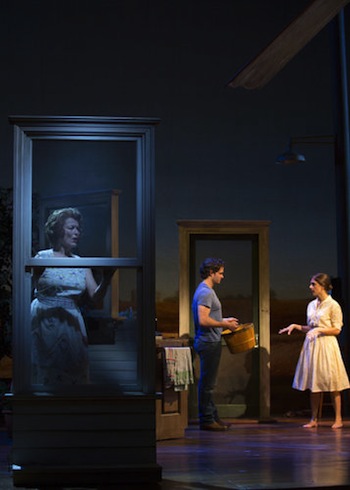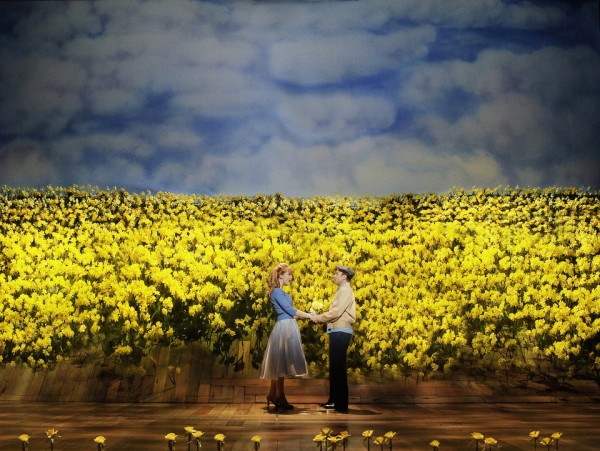Fuse Theater Review: Two New Musicals Hit Broadway — “Big Fish” and “The Bridges of Madison County”
Other than the teams that put together Rent and Wicked, film-makers have taken ‘creative’ control, turning Broadway into the land of retreads.
Big Fish at the Neil Simon Theater, New York.
The Bridges of Madison County, opening in previews on January 13, 2014 at the Schoenfeld Theatre, New York. Opening night, February 27.
By Iris Fanger
Time was when the professional stage served as a creative incubator for the film industry, especially when it came to musicals. You only need to recall such iconic songfests as The Sound of Music and West Side Story to realize how global distribution via their movie versions helped generate enduring popularity for the American musical.
Some of us are lucky enough to remember the original New York production of West Side Story in 1957 and the 1959 pre-Broadway try-out in Boston of The Sound of Music. (Richard Rodgers and Oscar Hammerstein II loved the old Ritz Hotel and the Colonial Theater, especially the oval marble-topped table in the vestibule of the theater’s ladies’ room. They were among the reasons they brought their out-of-town try-outs to the city.) The influence of the subsequent film versions (now digitalized, of course, and available on YouTube) continues to be huge, inspiring new generations of fan, resulting in constant revivals in high schools throughout the country and the 21st century’s television fairy tales about putting on a show.
But times have changed, with wholesale borrowings now going in the reverse direction. Other than the teams that put together Rent and Wicked, film-makers have taken ‘creative’ control, turning Broadway into the land of retreads. Perhaps one reason for the change in traffic flow is the end of the Golden Age of the American Musical: after Rodgers and Hammerstein, Leonard Bernstein, and Alan J. Lerner were gone, the scores became less melodic and book writers penned darker, more troubling stories.
Two new musicals, which I saw via their Broadway previews, are based on Hollywood films: Big Fish and The Bridges of Madison County. I saw Big Fish in New York in early September and caught The Bridges of Madison County this past August at the Williamstown Theatre Festival in the Berkshires.
After her big score with the musical version of The Producers, you cannot fault Susan Stroman, the director and choreographer of Big Fish, for trolling through celluloid for another nugget of box office gold. Like The Producers, Tim Burton’s Big Fish was a small film. (It was based on a winning book of sketches by Daniel Wallace.) In contrast to The Producers, which was set in the alternately seedy and glitzy dark alleys around Broadway, Big Fish takes place in rural Alabama. The protagonist of Big Fish and his family are ordinary folks, though Edward Bloom, in order to get through the pedestrian day, imagines himself the hero of oversized dreams. The Producers is populated by comic eccentrics, and they are much more appropriate for the amped-up commercial treatment demanded by high stakes commercial theater.
Big Fish centers on the conflict between Bloom and his son, Will, who grows up to become a just-the-facts-please kind of guy.The story is told at Bloom’s deathbed, when Will realizes that he never really knew his dad, a wanderer who came back with tall tales about his adventures: a huge fish caught and released on the day Will was born, encounters with a witch in the forest who predicts how and when Bloom would die, a giant in the circus, a mermaid in the lake, and a field of daffodils that bloom around a girl whom he would marry.
The chief dramatic thread is that Will is holding onto his anger at his father for telling what the former calls lies. The suggestion is that the son should have developed a way to accept the poignant value of Bloom’s imagination. (Could it be that Will has been unhappy since childhood because of the father’s absence?) Composer and lyricist Andrew Lippa gives Bloom a song right at the top, “Be A Hero,” to explain himself. Later on, there’s another for the company, “Ashton’s Favorite Son,” as Bloom leaves his small-town home for adventure. John August, who wrote the film script for Burton and the book for the new musical, never bothers to clarify why Will’s indignation has festered so deep and for so long.
Unfortunately, the charm of Burton’s film has not been translated to the stage, despite a Tony award-worthy portrayal of Edward Bloom by Norbert Leo Butz, who is supported by a strong cast. Stroman has goosed up the story with the requisite bloated Broadway production numbers, including one for the witch (Ciara Renee) who is based on a figure from dance history, the American Loie Fuller, who performed while draped in dozens of yards of silk attached to long rods in her hands. The circus number is distinguished by choreography for the back legs as well as the tails of a pair of huge elephants. Bobby Steggert is charismatic as Will, while Kate Baldwin gives the character of the mother a sympathetic gloss. Brad Oscar appears as the circus entrepreneur, a role played unforgettably by Danny DeVito in the film. I cannot predict if tinkering with the show during the final weeks before opening will make much of a difference.
The Bridges of Madison County came floating into its Williamstown Theatre Festival premiere on pre-sold waves of adoration inspired by the best-selling novel and film starring Meryl Streep and Clint Eastwood. Marsha Norman adapted the book and the film for the musical, while Jason Robert Brown supplied a lush score and lyrics. Despite the piece’s unabashed sentimentality — a repressed housewife is swept off her feet by a chance meeting with a rugged National Geographic photographer who stops by her Iowa farmhouse for directions — the musical’s emotional sweep equals that of the film. It doesn’t hurt that the male lead, singer-actor Steven Pasquale (as Robert Kincaid), is no less a hunk than Eastwood. Elena Shaddow endows Francesca with an earthy elegance and gorgeous soprano voice. (Kelli O’Hara, out on maternity leave, will take over the role in New York, even though Shaddow certainly carries the role with aplomb).
Director Bartlett Sher has resisted giving the production the big Broadway treatment: the sets and costumes evoking a mid-American locale are kept low-key. The film has been reproduced faithfully, except for an omission that might have given the musical more heft -— the scene where Robert witnesses a local woman, who presumably committed adultery, being shunned by the townspeople. The movie includes a parallel scene, in which Francesca befriends the woman and shares her anguish.
While discussing films turned into stage musicals, let’s not forget The Jungle Book, an ambitious musical inspired by the 1967 Disney cartoon, which is still pulling in full houses for the Huntington Theatre Company. Staged by Chicago-based director, Mary Zimmerman, and funded in part by Disney, I expect it is headed for New York.
Iris Fanger is a theater and dance critic based in Boston. She has written reviews and feature articles for the Boston Herald, Boston Phoenix, Christian Science Monitor, New York Times, and Patriot Ledger as well as for Dance Magazine and Dancing Times (London).
Former director of the Harvard Summer Dance Center, 1977-1995, she has taught at Lesley Graduate School and Tufts University, as well as Harvard and M.I.T. She received the 2005 Dance Champion Award from the Boston Dance Alliance and in 2008, the Outstanding Career Achievement Award from the Graduate School of Arts and Sciences at Tufts. She lectures widely on dance and theater history.
Tagged: Bartlett Sher, Big Fish, Broadway musicals, Susan Stroman


